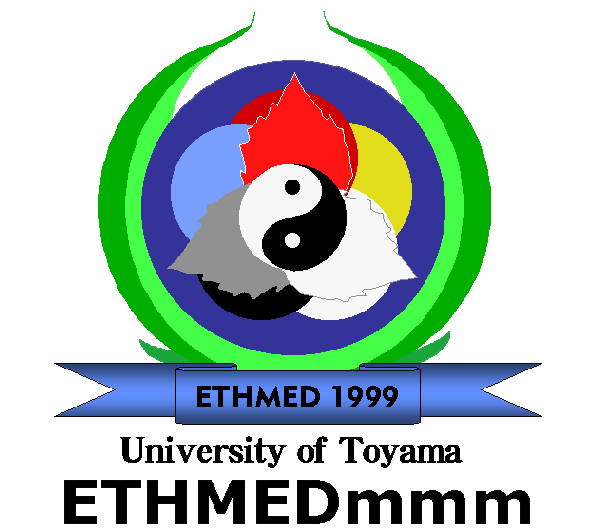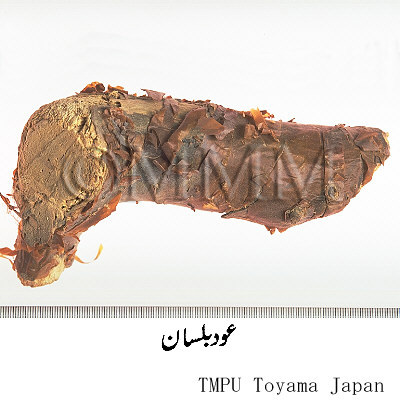Crude drug sample data base
※Click on the image to enlarge it.
The capital city, provincial capital city or the representative
location of its administrative area is indicated.
location of its administrative area is indicated.
Production area information
https://ethmed.toyama-wakan.net/img/pin_san.png
25.0700428
67.2847875
Collection information
Islamic Republic of Pakistan,Karachi [Karachi], Sind
https://ethmed.toyama-wakan.net/img/pin_nyu.png
Scientific information data base
| Crude drug name | Urudu name, English name | Ood-i-balsan, Balsam Tree | ||
|---|---|---|---|---|
| Arabic name / Persian name | Ood-i-balsan / - | |||
| crude drug image |
| |||
| Original plant name | Commiphora opobalsamum (L.) Engl. | |||
| Family name | Burseraceae | |||
| Used part | Stem (wood) | |||
| Distribution area | Found on both sides of the Red Sea. Also recorded from the Nubian Coast and in Abyssinia. Met on the Asiatic side at Ghizandad in Arabia, at Eden, Yemen and Egypt. Dioscorides stated that this tree is found in the remote places of the lower part of the land of the Jews, that is Palestine. The trees differ in roughness / height. | |||
| Description | Balsan is an Egyptian tree which grows only at one place called "Ain al-Shams". Its leaves and smell resemble those of common rue (sadhab) but the leaves are whitish. In height it is like the tree of ophthalmic barberry. It is fragrant, heavy and reddish wheatish in colour. The best ood (wood) is obtained from the twigs of trees which are thin and rough and give odour of Balsam. | |||
| Function and properties | Tonic to stomach, expectorant, purifying the brain from phlegmatic humours and deobstruent. | |||
| Specific actions | It is useful for the diseased viscera. | |||
| Frequency in use | Not found in India. | |||
| Common uses | Ulcer: It purifies ulcers especially when administered with orris root. Joint organs: It is useful in sciatica when taken in the form of a syrup. Its decoction is useful in convulsions. Organs of the head: It purifies the head from its ulcers. It is also useful in epilepsy and giddiness. Ocular organs: Balsan and its oil cleanse hemeralopia. Organs of the chest: The wood and seeds of Balsan are useful in pleuralgia, severe asthma, dysponea and pneumonia. Alimentary organs: Balsan is useful in weakness of digestion. Its decoction removes indigestion, cleanses the stomach, strengthens the liver and is useful in gripes. Excretory organs: It acts as diuretic. The decoction of its twigs or of its bark are taken. Fumigation with Balsan dries up the moistness or coldness of uterus, expels the foetus and placenta and is useful in all the painful conditions of uterus. Its decoction is useful in dysuria. Fevers: The oil of Balsan is useful in shivering. The ash of the bark of wood is kneaded in vinegar and is applied on piles to relieve pain of haemorrhoids/hemorrhoids. | |||
| Side effect | When used with milk, it acts as an antidote for poisons, snake bite, and hemlock seeds. It is also useful in cases of bites of scorpion. | |||
| Medical system | Unani | |||
| Traditional concept | Temperament | It is hot and dry in the third degree. According to Avicenna (Ibn Sina) the twig of Balsan is hot and dry in the second degree, the seeds are comparatively hotter than the twig and the oil is hotter than both of them. The oil is hot in the first stage of the third degree. | ||
| Drug effect | It purifies the brain from phlegmatic humour. It is harmful for intestines. | |||
| Dosage | 2 to 3 gm. | |||
| Substitute | Habb-Balsan (Commiphora opobalsamum), seeds. | |||
| Related drugs | Commiphora stocksiana Engl. It is found in Sind and Baluchistan. According to Usmanghani and Aftab the source of Balsan in Pakistan isC. stocksiana. | |||
| Corrigent (corrective) | Katira (Cochlospermum religiosum Alston), gum. | |||
| Important compound preparations | Jawarish Jalinus and Ma`jun Dabeedul Ward. | |||
| References | Reference book Tips! | Glossary of Indian Medicinal Plants, 1956. Chopra, R.N., Nayar, S.L. and Chopra, I.C., Council of Scientific & Industrial Research, New Delhi. - New Edition (1996) National Institute Science Communication; Supplement p 75. Makhzanul-Mufradat (Khawasul Adviyah), Hakeem Kabiruddin, Daftar Al-Masih, Qarol Bagh, Delhi. pp 406-407. Al-Qanun Fil-Tibb. Avicenna. (English translation of the critical Arabic text), Book 2, 1998. Hameed, H. A. (editor), Dept. of Islamic Studies, Jamia Hamdard (Hamdard University), New Delhi. pp 104-106. Al-Jamili Mufradt Al Adwiya Wal Aghziya (1197-1248 A.D.). Ibn al-Baytar. Vols. 1-3, 1985-1999. Central council for Research in Unani Medicine, Janakpuri, New Delhi. pp 271-274. Hamdard Pharmcopoeia of Eastern medicine, 1969. Said, H. M. (editor), The Times Press, Sadar Karachi. pp 81, 269-270. | ||
| Remarks | The fruit and the resin of this tree are used separately in Unani System of Medicine. Fruits are known as Habb balsan and resin is known as Roghan balsan. Both are attributed with wonderful medicinal properties. In potency the wood of the twigs is weaker than the fruits and the potency of the resin is higher than the both. The fruit is more commonly used in the compound preparations (Unani). | |||
| Last renewal date | 2024/03/11 | |||


